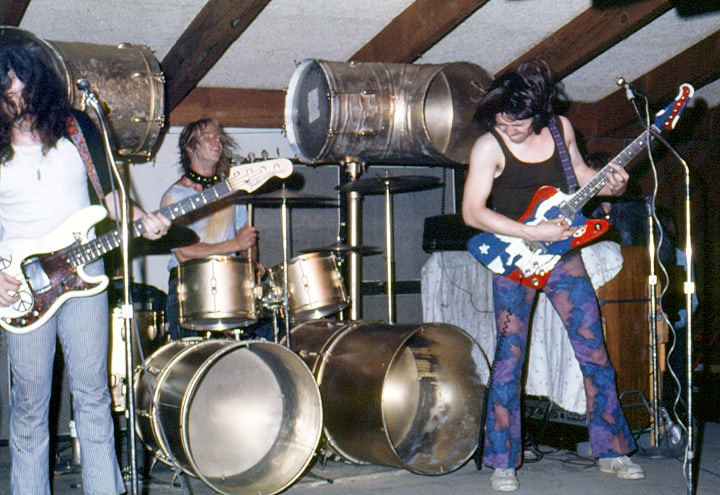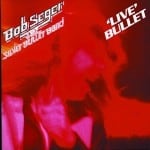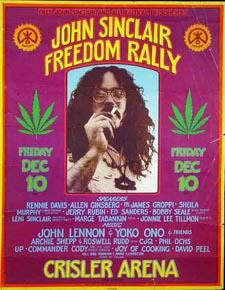By Scott Westerman – Curator
 May 6th, 1945. The Second World War in Europe ends as the Germans announce that they will sign surrender documents. While most eyes are focused overseas, life goes on in Detroit. At Henry Ford Hospital, Robert Seger is born. By the time he was six the family had relocated to Ann Arbor, Michigan. Seger’s father left the family when Bob was ten and the young man made his way through the Ann Arbor Public Schools, attending Tappan Junior High and graduating from what was then called Ann Arbor High School in 1963.
May 6th, 1945. The Second World War in Europe ends as the Germans announce that they will sign surrender documents. While most eyes are focused overseas, life goes on in Detroit. At Henry Ford Hospital, Robert Seger is born. By the time he was six the family had relocated to Ann Arbor, Michigan. Seger’s father left the family when Bob was ten and the young man made his way through the Ann Arbor Public Schools, attending Tappan Junior High and graduating from what was then called Ann Arbor High School in 1963.
His classmates remember him as an athlete, one of the best runners in the State, and as a man on a mission… to make music.
As a sophomore, Bob Seger joined his first notable band, The Decibels and after graduation he he played with The Town Criers and Doug Brown and the Omens. It was with the Omens that he recorded “Ballad of the Yellow Beret”, a parody of the then popular Barry Sadler tune “Ballad of the Green Berets”. When Sadler threatened a lawsuit, the record was withdrawn, but Seger’s taste for writing and performing his signature soulful, blusy mash-up of James Brown, Little Richard, Elvis and Van Morrison was cast in stone.
He took on a manager, Ed “Punch” Andrews, and with his new group, The Last Heard, recorded “East Side Story“. The record sold a half a million copies and lead to a recording contract with Cameo Parkway. “Heavy Music” followed and even as it rocketed to the upper reaches of the WKNR Music Guide, Seger suffered his first professional setback when the Cameo label folded.
 What followed were years of tenacious hard work and a cult following in the Midwest that kept the various iterations of his band traveling and gigging wherever they could find a venue. It was during this time that Seger tried his hand a producing. The group was called the Mushrooms and the experience lead to a lifelong friendship with band member Glen Frey, with whom Seger collaborated as co-author of the Eagle’s smash “Heartache Tonight“.
What followed were years of tenacious hard work and a cult following in the Midwest that kept the various iterations of his band traveling and gigging wherever they could find a venue. It was during this time that Seger tried his hand a producing. The group was called the Mushrooms and the experience lead to a lifelong friendship with band member Glen Frey, with whom Seger collaborated as co-author of the Eagle’s smash “Heartache Tonight“.
If you were from the Detroit area, you probably own every album Bob Seger ever recorded. You celebrated his first national hit record when “Ramblin Gamblin Man’s” heavy airplay on WKNR helped propel it to number 17 on the Billboard charts. Your collection of Bob Seger LPs included titles like “Brand New Morning” and “Smokin O.P.s”. And you knew that if he was on the concert bill, the venue would be rockin and you’d get your money’s worth.
It is said that everybody has talent and persistence is the magic quality that separates the stars from the dreamers. That Michigan blue collar work ethic would sustain Bob Seger, even as many of his peers abandoned their rock n roll dreams for “real jobs”.
In 1974, Seger launched The Silver Bullet Band. “Get Out of Denver” cracked the hot 100 that same year and in 75, we DJ’s were playing “Nutbush City Limits” as an album cut and could rely on “Katmandu” as a guaranteed catalyst to get everyone out on the dance floor.
 1976 was Bob Seger’s magic year. “Live Bullet”, a double album recorded at Detroit’s Cobo Arena, became a national sensation. What followed was a decade of consistent success. “Live Bullet” went platinum as did “Night Moves”. Seger’s “Like a Rock” became the brand definition for Chevy trucks, and Tom Cruise’s karaoke rendition of “Old Time Rock and Roll” in the film Risky Business cemented the tune as one of the greatest rock records of all time.
1976 was Bob Seger’s magic year. “Live Bullet”, a double album recorded at Detroit’s Cobo Arena, became a national sensation. What followed was a decade of consistent success. “Live Bullet” went platinum as did “Night Moves”. Seger’s “Like a Rock” became the brand definition for Chevy trucks, and Tom Cruise’s karaoke rendition of “Old Time Rock and Roll” in the film Risky Business cemented the tune as one of the greatest rock records of all time.
In the years since, Seger has balanced his career passions with family life, the holy grail that we all constantly seek. He hasn’t toured as much and his rare gigs instantly sell out. It’s still hard to find his early Cameo Parkway stuff on CD; most of us have burned MP3s off of well worn 45s. But even with the scratches, we still feel like “going insane when the drums begin to pound”. We can be whipped into a frenzy by “Rock and Roll Never Forgets” and feel the raw emotion whenever “Main Street” comes on the radio.
On March 15, 2004, Kid Rock, a Seger / Andrews protege, inducted his mentor into Rock and Roll Hall of Fame. But the event was just an affirmation of what we already knew. For those of us in the Keener Generation, Bob Seger came into our lives like a freight train. The inimitable voice, the poetry and the music were all in perfect sync with who we were and who we were trying to become.
 My most vivid Bob Seger memory happened on December 10, 1971. I was a cub reporter and sometime disk jockey at WPAG in Ann Arbor and convinced my boss to get me press credentials for the John Sinclair Freedom Rally that was held at what’s now called Crisler Arena. John Lennon and Yoko Ono were the headliners. Stevie Wonder, Phil Ochs, Steve Miller, and Commander Cody were also on the bill. But the only thing I really remember about that night was when Bob Seger took the stage.
My most vivid Bob Seger memory happened on December 10, 1971. I was a cub reporter and sometime disk jockey at WPAG in Ann Arbor and convinced my boss to get me press credentials for the John Sinclair Freedom Rally that was held at what’s now called Crisler Arena. John Lennon and Yoko Ono were the headliners. Stevie Wonder, Phil Ochs, Steve Miller, and Commander Cody were also on the bill. But the only thing I really remember about that night was when Bob Seger took the stage.
He was backed by Teegarden and VanWinkle, who were enjoying a one hit wonder experience with “God, Love and Rock and Roll“. Seger connected instantly with the crowd and barreled through a 45 minute set with the energy of a ballistic missile. Time seemed to stand still, the seconds ticking to the thunderous bass line. In that moment, the politics of the evening evaporated. Crisler became one gargantuan dance hall and even those of us in the press gallery were on our feet.
There was a ton of talent there that December night. And as the event progressed into the wee hours of the morning the general consensus was that the true highlight of the experience was Ann Arbor’s favorite son.
Over a career that spans five decades, anyone who ever saw Bob Seger perform felt exactly the same way.

